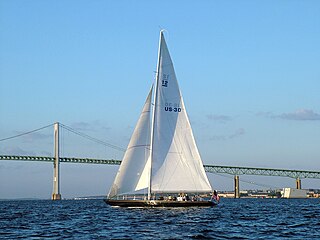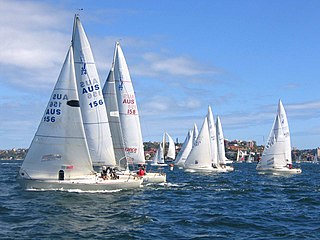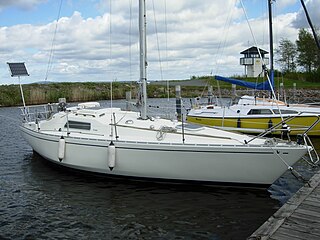Related Research Articles

Yacht racing is a form of sport involving sailing yachts and larger sailboats, as distinguished from dinghy racing. It is composed of multiple yachts, in direct competition, racing around a course marked by buoys or other fixed navigational devices or racing longer distances across open water from point-to-point. It can involve a series of races when buoy racing or multiple legs when point-to-point racing.

A maxi yacht usually refers to a racing yacht of at least 70 feet (21 m) in length.
The Portsmouth Yardstick (PY) or Portsmouth handicap scheme is a term used for a number of related systems of empirical handicapping used primarily in small sailboat racing.
One-Design is a racing method which may be adopted in sports which use complex equipment, whereby all vehicles, gliders or boats have identical or very similar designs or models. In motor racing, it is also known as Spec series, and one-make racing.

The 12 Metre class is a rating class for racing sailboats that are designed to the International rule. It enables fair competition between boats that rate in the class whilst retaining the freedom to experiment with the details of their designs. The designation "12 Metre" does not refer to any single measurement on the boat, and is not referencing the vessels overall length, rather, measures the sum of the components directed by the formula which governs design and construction parameters. Typically 12 Metre class boats range from 65 to 75 feet in length overall; they are most often sloop-rigged, with masts roughly 85 feet tall.

The International rule, also known as the Metre rule, was created for the measuring and rating of yachts to allow different designs of yacht to race together under a handicap system. Prior to the ratification of the International rule in 1907, countries raced yachts under their own national rules and international competition was always subject to various forms of subjective handicapping.
Performance Handicap Racing Fleet (PHRF) is a handicapping system used for yacht racing in North America. It allows dissimilar classes of sailboats to be raced against each other. The aim is to cancel out the inherent advantages and disadvantages of each class of boats, so that results reflect crew skill rather than equipment superiority.
Gary Mull was an American yacht designer who created a large number of popular fiberglass sailboats.
IRC is a system of handicapping sailboats and yachts for the purpose of racing. It is managed by the Royal Ocean Racing Club in the United Kingdom through their dedicated Rating Office. and UNCL in France.
The term sportsboat first appeared in the late 1980s and early 1990s to describe high performance trailer yachts with major compromises in accommodation and weight compared to traditional designs of the same size.
The North 26 is a boat designed by Julian D Everitt in 1982, Cowes UK, designer of the very successful E boat. Big brother to the E-boat, intended for Yacht racing Inshore and in Junior Offshore Group races to rate under Channel now IRC measurement rule. Examples race the English Channel and have a wide flat sole plate that enables them to sit the mud in English ports with the keel retracted. This feature also enables safe beach sitting whilst cruising and use as a Trailer yacht.
Svenskt Respitsystem (SRS), formerly known as Leading Yard Stick and Lidingö Yard Stick (LYS). SRS is a semi-empirically based handicapping system used in yacht racing in the Nordic countries. The first version of the handicap system was developed in 1970 by the Swedish yacht designer Lars-Olof Norlin. He based the system on regatta results from the Round Lidingö Race. His own design, Allegro 27, was used as the benchmark and was by definition assigned a LYS value of 1.00.
The Aegean Rally is an international sailing regatta held in Greece. Held annually since 1964, it is organised by the Hellenic Offshore Racing Club. The regatta is broken up into three to six individual competitions, with the course taking in several of the Aegean Islands after a start in Faleron Bay. The event is strongly affected by the meltemi, the brisk local north-easterly wind which blows from dawn to dusk at between fifteen and twenty-five knots, driven by a local weather system & documented since ancient times.For the 2018 race, qualified boats included ORC International, ORC Club, IRC 1 and IRC 2 measured boats with LOA greater than 6.00 m and with current valid rating certificate. Classic yachts and traditional boats are eligible to enter the event’s first race.

Sailing as a sport involves a variety of competitive sailing formats that are sanctioned through various sailing federations and yacht clubs. Racing disciplines include matches within a fleet of sailing craft, between a pair thereof or among teams. Additionally, there are specialized competitions that include setting speed records. Racing formats include both closed courses and point-to-point contests; they may be in sheltered waters, coast-wise or on the open ocean. Most competitions are held within defined classes or ratings that either entail one type of sailing craft to ensure a contest primarily of skill or rating the sailing craft to create classifications or handicaps.

Half Ton class was an offshore sailing class of the International Offshore Rule racing the Half Ton Cup between 1967 and 1993.
Handicap forms for sailing vessels in sailing races have varied throughout history, and they also vary by country, and by sailing organisation. Sailing handicap standards exist internationally, nationally, and within individual sailing clubs.